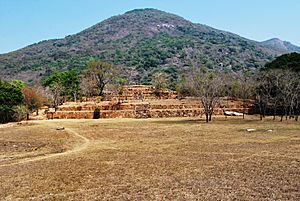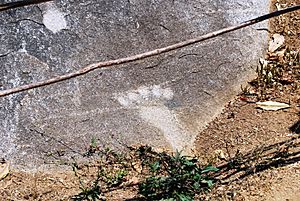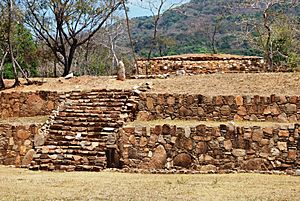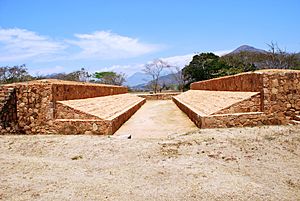Tehuacalco facts for kids
Tehuacalco is an ancient site located near the city of Chilpancingo in Guerrero, Mexico. It was the first place linked to the Yope people that archaeologists explored, starting in the 2000s. The site sits on a hill surrounded by tall mountains. The Yope people thought these mountains were very important. Four of them pointed to the main directions (north, south, east, west). Another mountain, called Compuerta, helped them track the sun's path. They used it to mark special days like equinoxes and solstices, which are when the sun rises in a specific spot. Tehuacalco was used for ceremonies from about 400 CE to 1100 CE. The site opened for visitors in 2008.
Where is Tehuacalco?
This ancient site is in the state of Guerrero. It is close to Chilpancingo, the state capital. It's also near the main highway that connects Mexico City to Acapulco. The small towns closest to Tehuacalco are La Haciendita, Camizal de la Vía, El Potrero, and Garrapatas. The biggest nearby town is Tierra Colorada. The area around Tehuacalco is a tropical forest. Its trees lose most of their leaves during the dry season, which is in the fall and winter.
History of Tehuacalco
The name Tehuacalco comes from the Nahuatl language. The word "tehuacalli" means holes drilled into stones for special rituals. So, Tehuacalco can mean "place of the stone box," "house of priests," or "house of the sacred water."
Archaeologists mostly connect Tehuacalco with the Yope people. However, it's possible that other groups, like the Yopime or Tlapaneca, also lived here. People started living at the site around 400 CE. It was most important between 650 CE and 1100 CE. During this time, the main living area covered about 80 football fields. The ceremonial center was about 12 football fields big. Most of the buildings were constructed when the Toltec civilization was very powerful.
The Yope people of Tehuacalco were farmers who stayed in one place. They had different social groups, with rulers and priests at the top. Below them were warriors, merchants, and craftspeople. They ate meat from hunting and grew corn. The Yope believed that mountains held water and seeds. They worshipped these mountains to make sure their crops grew well. They also thought the sun was eaten by a monster every evening. The sun then had to fight in the underworld to rise again the next morning. They believed they had to "feed" the sun to help it return.
The area around the site was called Yopitzingo in Nahuatl. It was one of the few places the Aztecs could not conquer. This was even true during the late Post Classic period. By then, the Yope had become semi-nomadic, meaning they moved around and farmed sometimes.
After the Spanish arrived, European diseases greatly reduced the Yope population. They did not fully accept Spanish rule and even had a big rebellion. But the Spanish crushed this rebellion. They then scattered the remaining Yope people to other settlements.
Tehuacalco is the first Yope site that archaeologists have explored in detail. This work happened in the 2000s. So far, 19 buildings have been found. Most of these were discovered during fieldwork in 2006 and 2007. After that, about 40 million pesos were spent to prepare the site for visitors. It opened to the public in 2008. Tehuacalco was one of 12 sites opened during the time Felipe Calderón was president (2006-2012). There is a welcome center with information in Spanish. The signs at the site itself are in both Spanish and English.
What is at the site?
The site is on a hill, surrounded by even taller mountains. Four of these mountains—Compuerta, Capulín, Tierra Colorada, and Gavilpan—mark the main directions. The site's hill itself was seen as a "fifth" direction, a place where special power was focused.
The Tehuacalco site has four main features:
- Areas with rock carvings.
- The surrounding mountain landscape.
- Pyramid-like buildings.
- Caves in the hills that held offerings.
The rock carvings include the Piedra de los Pies Pintados, which has foot markings. Monument W has circular patterns that were used to count lunar cycles. Archaeologists have explored 57 caves on the sides of Compuerta mountain. They found offerings like braziers and incense burners inside. These caves were used for worshipping the sun.
The site also has many features related to archaeoastronomy. This means studying how ancient people used buildings and natural features to observe the sky. The site is built facing Compuerta Mountain. This mountain and smaller peaks next to it were used to mark the equinoxes and solstices. This is because the sun would rise from behind them on those specific days.
Tehuacalco was a ceremonial center with a large open area (plaza). This plaza was surrounded by various pyramid bases and other buildings. The buildings here have a special way of being built. They used large rocks with smaller, flat stones and red clay filling the gaps. This building style helped the structures survive earthquakes.
Of the buildings found, eight are large and important. The rest are smaller. The most important ones include four big pyramid-like structures and a Mesoamerican ball court. Some of the pyramid bases are in surprisingly good condition. The four main buildings are called Encinera (or Main Temple), the Palace, the Templo del Espejo de Agua, and Platform W.
The Palace, also known as Building Five, is the largest building at the site. Its base measures 80 meters on each side. It has sunken courtyards and several open areas. The La Encinera building is 20 meters tall. It was a place where priests and rulers performed many rituals. The ball court is 37.8 meters long. Platform W had homes for important people, with inner courtyards and drainage systems. However, the most sacred part of the site is a hill. This hill was a special place for worshipping water and rain. Some of the smaller buildings include the Templo Verde, the Templo Rojo, and La Anona. The last two form what is called the Solar Group.
See also
 In Spanish: Tehuacalco para niños
In Spanish: Tehuacalco para niños





